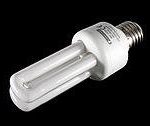How green are Compact Fluorescent Lights (CFLs)?
Some countries and states like Australia, California, and the European Union plan in the near future to ban incandescent light bulbs, to the benefit of Compact Fluorescent Lights, Lamps (CFLs).
There are two main advantages given by Fluorescent bulbs (CFLs) : …
There are two main advantages given by Fluorescent bulbs (CFLs) : …
- High light efficiency (quantity of light produced per watt of electricity), multiplied by a factor of 3 to 4 compared to incandescent lamps,
- Lifetime multiplied by a factor of 10.
Worldwide, this represents a huge quantity of electricity saving and CO2 emission!
But is it as green as it seems after all?
Some aspects related to this technology are less idyllic and should be considered in the global assessment:
- The main issue is the presence of mercury in the fluorescent tube, as well as some toxic materials such as lead in the necessary electronic circuit. That is why collecting and recycling of spent CFLs is absolutely mandatory in order to avoid spilling of the environment.
- CFLs are much more complex and heavier than incandescent lamps. This results in a higher need for energy for manufacturing and delivery. Recycling is also requesting energy, so that, at the end, this partly counterbalances the advantage of lower energy consumption.
- In cold countries, the heat produced by incandescent lamps participates in the global heating of the homes. Reducing the heat produced by lamps must simply be compensated by more energy produced by the heating system.
- The current absorbed by the electronic circuit is far from a pure sinusoid. This means that a higher current is necessary for a given power compared to a purely resistive circuit such as an incandescent lamp. The current distortion (harmonics …) may be responsible for additional losses and disturbances in the supply network.
- And last aspect: as CFLs do not operate instantaneously and need a few minutes before achieving full lighting efficiency, people are inclined to let them turned on, even if it is not necessary.
Are Fluorescent bulbs (CFLs) to be the only available anyway everywhere in the future?
If yes, you'll have to accept some drawbacks:
- Higher replacement cost, particularly worrying for bulbs turned-on infrequently,
- CFLs are sensitive to extreme temperatures, making them unsuitable for outdoor usage,
- Frequent turning on and off significantly reduces the lifetime, so CFLs are not appropriate in such conditions,
- No possibility of dimming,
- No possibility of directional lighting.

 Some countries and states like Australia, California, and the European Union plan in the near future to ban incandescent light bulbs, to the benefit of
Some countries and states like Australia, California, and the European Union plan in the near future to ban incandescent light bulbs, to the benefit of
No comments:
Post a Comment